|
|
|
 |
|
“AND
THIS SAME HEZEKIAH ALSO STOPPED THE UPPER SPRING OF THE
WATERS OF THE GIHON, AND BROUGHT THEM STRAIGHT DOWN ON
THE WEST SIDE OF THE CITY OF DAVID.”
II CHRONICLES 32
|
|

|
 |
| |
Do you
crave adventure with a biblical twist?
Then put on your rafting sandals and bring a
flashlight to explore
Hezekiah’s Tunnel. This 8th century BC
engineering feat diverted the water from Jerusalem’s
Gihon Spring and brought it over to the western spur
of the city. When the Assyrians from today’s
northern Iraq came to besiege the capital of Judea,
they found a heavily fortified Jerusalem with a
protected water supply.
You can read all about it in II Kings chapters 18
through 20 and II Chronicles chapter 32. If
you happen to be reading an older King James
version, it has an unusually vivid description of
the disastrous plague which struck 185,000 Assyrian
soldiers camped outside the city, “And when they
arose early in the morning, behold, they were all
dead corpses.” (II Kings 19:35)
Hezekiah’s Tunnel is one of the
authentic ruins of
ancient Jerusalem. And splashing through the tunnel
can be one of the thrilling highlights of your
pilgrimage to Jerusalem, D.C. (David’s Capital).
Located in the “City of David,”
Hezekiah’s Tunnel is
south of the Old City’s Dung Gate. If you
intend to explore the tunnel with more than 10
people, then call the City of David Visitors Center
for an advance reservation.
|
|
Twelve-year-old Sonia Simon, who splashed through
Hezekiah's Tunnel with her sister, cousins,
grandparents and twenty-eight other pilgrims, says,
"Along with camel-riding, my favorite was going
through Hezekiah's Tunnel in the dark, singing!" |
| |
|
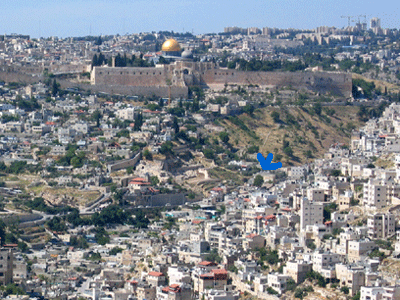 |
|
Photo: Gila
Yudkin |
|
The blue arrow points to the
entrance to Hezekiah’s Tunnel |
| |
Coming to Jerusalem
this year? Would you
like to find the venues where you can quietly be
transported back in your imagination to the time
of Jesus? To David? To Abraham?
Are you a camera buff who would like to bring
home a collection of exotic photos no one else
has? Are you eager to eat hummus or kubbeh
elbow-to-elbow with the "natives" -- or is
dining in the style of King Solomon and the
Queen of Sheba more to your taste?
Make every
minute matter while you "Explore
Jerusalem's Soul" with Gila's guide.
This up-to-date PDF (Adobe Acrobat)
46-page guide gives you the Top Ten places to
meditate on the Bible, the Top Ten lesser-known
churches worth visiting, the Top Ten most
rewarding roof-top views and the Top Ten places
for Middle Eastern soul food.
More...
|
Are you
a romantic who loves to read poetry by candlelight?
Actually, even if you aren’t romantically inclined,
you may be interested in the just opened
Song of Songs Garden
in the biblical crafts outdoor museum at
Ein Yael.
Located in the Valley of Refaim in southwest
Jerusalem, opposite the Biblical Zoo, Ein Yael sits
on a living spring over terraces constructed by
farmers over 2,000 years ago. Wheat, olives,
grapes, figs, pomegranates, almonds, walnuts and
apples, grown on its slopes, fed the population of
Jerusalem which reached 100,000 at the peak of the
Second Temple period.
The Song of Songs Garden has been designed as a maze
of grape arbors, fruit trees and perfume bushes
descending to the “locked garden” complete with
bridal canopy and the “king’s rooms,” so alluringly
described in the Song of Songs. “My sister, my
bride, [you are] a locked garden – a locked garden
and a sealed spring.” (Song of Songs 4:12) |
| |
|
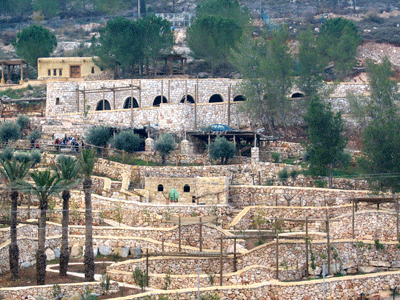 |
|
Photo: Gila
Yudkin |
|
Terracing for “Song of Songs”
perfume & spice plants at Ein Yael |
| |
Have you
become a biblical archeology buff?
You’ve visited the Garden Tomb and the Church of the
Holy Sepulcher, but now you want to visit an
“authentic” rolling stone tomb from the period of
Jesus? You have a choice: Jerusalem has two.
One is at the Tomb of the
Kings, north of the Old City on 46
Saladin Street. It is believed to be the tomb of
Helene, Queen of Adiabene (modern-day Kurdistan)
whose remains were brought to Jerusalem for burial. It’s a magnificent tomb complex with the frieze
quite well preserved.
|
|
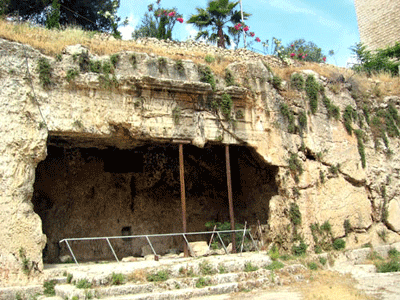 |
|
Photo: Gila
Yudkin |
|
Façade of the Tomb of the Kings |
| |
A little
turquoise door to the left of the main entrance
labeled “Tombeau des Rois” is usually open in the
mornings. Walk in, smile or wave to a hidden camera
and turn right. It’s definitely worth a visit. Come
dressed in dirty clothes and bring a flashlight if
you’d like to crawl around inside and examine the
burial niches.
Another “rolling stone tomb” can be found behind the
King David Hotel in the direction of the Old City. This tomb structure is the property of the Greek
Orthodox Church, but it is usually accessible. This
tomb is reputed to be a
monument to the family of Herod the Great. |
| |
|
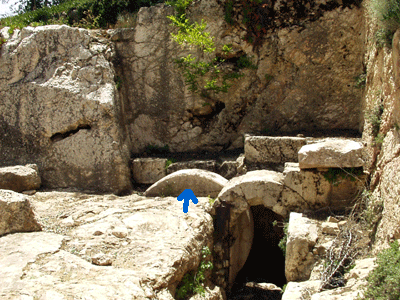 |
|
Photo: Gila
Yudkin |
|
Blue arrow points to rolling stone
which once blocked the entrance |
| |
Would
you like to identify with a Jerusalem family during
the Roman siege of the city in 70 AD?
Then visit the Burnt House
in the Jewish Quarter of the Old City.
Excavated in the 1970s, the basement of the Burnt
House was apparently an incense factory belonging to
the Kathros family, one of the families which served
as priests in the Second Temple during its last
days. On exhibition are finds from the dig: a number
of storage jars, weights and measures and a spear
belonging to one of the residents. Today, the Burnt
House hosts a very moving video which speculates
about the inner conflict experienced by the Jewish
inhabitants as they had to decide whether or not to
join the revolt. Of course everyone wants to live
with liberty – but at the price of the destruction
of the sacred Temple?
To learn more about the Roman siege of Jerusalem,
see Holy Land Headliners, "The
Peacenik Rabbi and the Burning Temple." |
| |
|
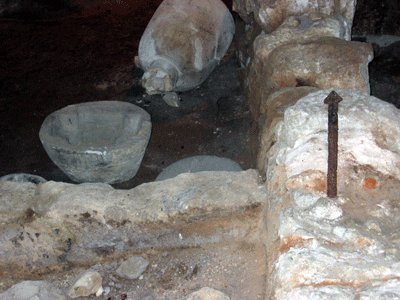 |
|
Photo: Gila
Yudkin |
|
Spear found in the house burnt in
the 70 AD fire |
| |
| |
Would you
like a taste of nineteenth century
Jerusalem?
Visit Mea Shearim,
Jerusalem’s ultra-Orthodox neighborhood
north of the Old City. Once populated by
“progressive” thinkers who dared to reside
outside the walled
city, today’s Mea Shearim residents are very
conservative and ask that visitors,
particularly women, come “modestly” dressed.
That means legs, shoulders and
elbows covered.
Families have on the average six to eight
children. You’ll notice the girls
always wear skirts and dresses, even for
outdoor play. The boys over age three
wear a skullcap called a Yarmulka or
Kipa and have side curls called
payot. Marriages are arranged by
matchmakers.
A word to the wise: Be discreet in
taking photos, and none whatsoever on the
Jewish Sabbath.
|
|
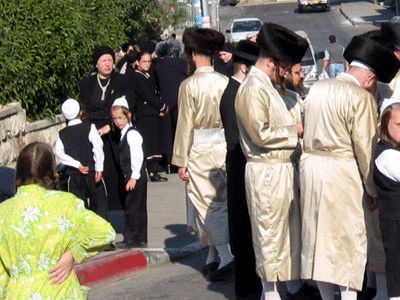 |
|
Photo:
Gila Yudkin |
|
“Street party” in Mea
Shearim |
| |
| Would you
like to know the meaning of "modest dress,"
"shabbat elevator" or "bar mitzvah"?
See Holy
Land Jargon. |
| |
| Would you like to learn some handy Hebrew
phrases which will help you connect with
people you’ll be meeting on your journey in
the Holy Land? See
Hebrew for Pilgrims. |
| |
| Are you a
fan of Mark Twain? Then you may enjoy
Mark Twain's tips for Holy Land pilgrims. |
| |
|
Ten Tips for a Terrific
Temple Mount Tour suggests how to
reap the maximum during your visit on the
Temple Mount |
|
|
|
GILA
YUDKIN
•
TCHERNIKOVSKI
64A
•
JERUSALEM
•
ISRAEL
gila@itsgila.com
HOME
•
HOLY
LAND
HEROINES
•
SONGS
& PRAISE •
ABOUT GILA
|
|

